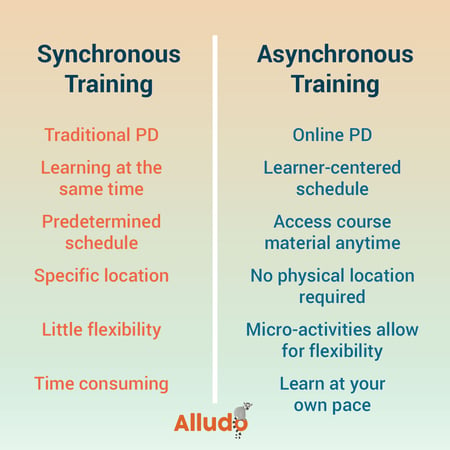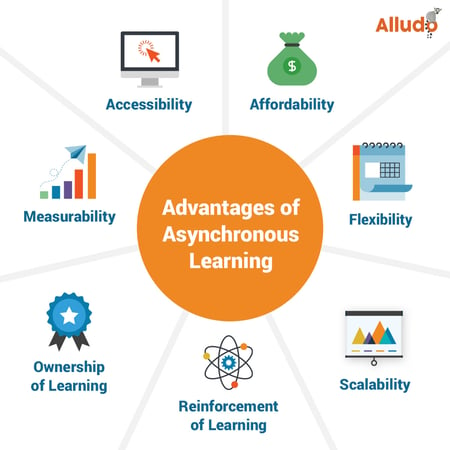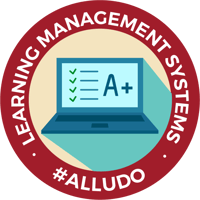Quick Tip Wednesday: How to Set Up a Gratitude Month
Welcome back to Quick Tip Wednesday!
6 min read
Julia Francis : Feb 21, 2022 2:00:00 PM

Teachers have three loves: love of learning, love of learners, and the love of bringing the first two loves together. ~ Scott Hayden
A teacher’s work goes far beyond the classroom. While the time a teacher spends with their students is at the heart of their jobs, they may spend hours creating lesson plans, grading papers, and thinking about how best to reach their students. And that doesn’t include the time they must spend in professional development!
At Alludo, we believe that teachers’ time is valuable and we want to make professional learning as easy and convenient as possible. It’s for that reason that we create online PD for teachers. Here’s what you need to know about asynchronous online PD, including eight must-have elements to include.
Before we explain the necessary elements of online asynchronous PD for teachers, let’s talk about the differences between synchronous and asynchronous training.

Synchronous training might also be referred to as traditional professional development. It involves all learners participating in professional learning at the same time on a predetermined schedule.
Before online learning was widely available, most teacher professional development was synchronous. It required teachers to travel to specified locations and attend classes for a specified time.
While there’s nothing wrong with synchronous training in theory, what school boards and administrators now realize is that there’s a better way. Synchronous training is not as respectful of teachers’ time as asynchronous learning. There is very little flexibility and, depending on where the training takes place, it can be time-consuming and deeply inconvenient for teachers.
Asynchronous training allows learners to participate at a time of their choosing. Instead of juggling a pre-ordained class schedule that may or may not be convenient for them, teachers can participate in online learning at any time they choose. They can also access course materials at any time that’s convenient for them.
Imagine the life of a busy teacher. During her time away from school, she may need to juggle caring for her children, maintaining a relationship with her spouse, visiting an aging parent, and dozens of other responsibilities. Adding professional development to the list may make her feel overwhelmed, particularly if she must rearrange her other responsibilities to make time for it.
Asynchronous training is at the heart of learner-centered online professional development. It respects teachers’ time, giving them the freedom to complete continuing education on their own schedule and at their convenience.
Why is asynchronous learning a necessary element of learner-centered professional development? Here are some advantages to keep in mind.

Accessibility is one of the biggest advantages of asynchronous learning and a particularly important one for educators who may live in rural or remote areas. Instead of adding hours of driving to their already-long days, teachers can access online professional development from the comfort of home.
When learning happens in person, there are expenses that drive prices up and make professional development a financial hardship. With asynchronous learning, there’s no need to hire a teacher or pay for a location. In many cases, that means asynchronous learning is more affordable than traditional training. For example, Alludo pricing starts at just $3 per adult learner per month. Get a custom PD quote for your district or school here!
Another key advantage of asynchronous learning is its flexibility. The timing is flexible since teachers can access online courses and materials at any time. It’s also flexible in the sense that school districts can adapt learning to their needs and the needs of teachers. If you want to incorporate blended learning or flipped learning into your PD system, we can help you do that. The result is a system that will allow teachers to design individual learning plans that add new skills and help them connect with students.
Scaling synchronous learning can be an expensive endeavor. With asynchronous learning, scalability is built in. There’s no limit to how many teachers can access an online course because the information is stored digitally. Without having to worry about a physical classroom, school districts can easily scale learning to accommodate their needs and the needs of all employees.
When educators have easy access to course materials online, it allows them to reinforce what they learn. They can reference course materials at any time to refresh their memories and confirm what they have learned.
When teachers participate in online, learner-centered PD, particularly asynchronous learning, they can take ownership of their learning, both in terms of what they learn and when and how they learn it. There’s plenty of research that shows when teachers are given a voice and a choice, they are more likely to be engaged in PD.
Asynchronous online learning results are far easier to measure than results for synchronous learning. The Alludo approach involves providing school districts with an array of PD metrics, allowing them to track teacher participation and hours completed. They can also collect supporting and indirect evidence of learning to ensure the professional development course is delivering what teachers and students need.
Now that you know why asynchronous learning is at the heart of the learner-centered ideology, let’s review the seven must-have elements of online asynchronous PD for teachers.

Micro-learning activities are an essential component of asynchronous PD for teachers. These short lessons allow learners to focus on the topics where they need skills training as well as those topics that inspire them. Lessons can be completed quickly and there’s evidence that micro-learning can be particularly effective when combined with gamification and quizzes, which you’ll see mentioned on our list as well.
The second necessary element of asynchronous learning is on-demand audio and video. Educators should be able to access course materials on any schedule they choose. On-demand access is one of the best ways we know to drive teacher participation and engagement.
Just as it’s important to have on-demand audio and video, it’s also important to record presentations, lectures, and technology demos. Teachers-as-learners are more likely to retain what they learn when they can access these materials whenever it is most convenient to them. Recorded demos are particularly important when technology training is required.
You know now that it's essential to have on-demand audio & video and pre-recorded materials, and it's important that these things be accessible to teachers who are participating in PD at any time. Every teacher has a unique schedule and the best way to encourage their engagement in professional development opportunities is to make it easy and convenient for them to complete the required training and pursue their individual learning goals.
We already mentioned that asynchronous learning is perfect for school districts where there’s a desire to incorporate blended learning and flipped learning into PD. Ideally, asynchronous learning should incorporate a variety of activities to encourage practical applications of what teachers learn. This may include classroom simulations and other activities to help faculty internalize what they have learned and prepare to put it into practice in the classroom.
There is more than one way to track progress with online learning. One crucial element that school districts can use to gather evidence of learning is to include quizzes in asynchronous PD. Quizzes allow teachers to measure their progress while also allowing administrators to measure the effectiveness of PD and its impact on teachers and student learning.
Gamification is a key element of the PD platform we designed at Alludo. We believe that gamification fosters a healthy level of competition among teachers. At the same time, it makes learning fun – something that encourages teachers to participate and keeps them motivated to pursue individual learning goals.
One of the best things about asynchronous learning is that it encourages collaboration by making professional learning both accessible and flexible. We believe that collaboration among teachers is essential. Not only does it foster a sense of collegiality in schools, it also makes teachers feel supported – and that can, in turn, reduce teacher burnout and turnover.
At Alludo, we design asynchronous online learning environments for school districts across the country. We do it by embracing all the above elements of asynchronous learning, including the following:
 |
 |
 |
The Oxnard Union High School District came to use for assistance designing a gamified learning system that would provide teachers with the technology training they needed to meet the district’s goals. The resulting system has engaged more than 1100 teachers since the initial launch. It also encouraged more teacher collaboration and built a sense of community among them while promoting the school district’s objectives.
Asynchronous learning is ideal for the modern school district because it makes online professional development courses accessible and convenient to all teachers. The result is greater engagement, less teacher turnover, and more success meeting school district goals.
Want to reach up to 100% PD in your district? See how Alludo can help make it happen with our free professional development platform trial, including:
.png)
Welcome back to Quick Tip Wednesday!

Mid-Year Reflection: Your Secret to a Stronger Second Semester
A great way to get your learners engaged in your Alludo program is by keeping the content in your program up-to-date and relevant. Rebecca has...